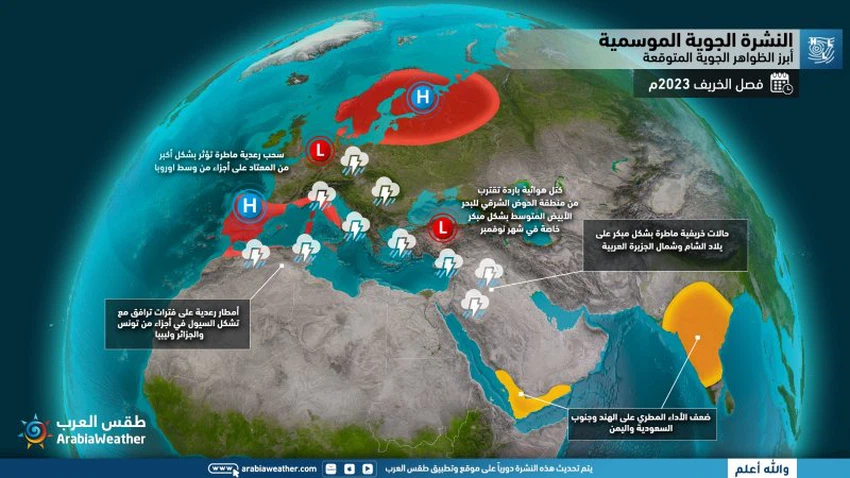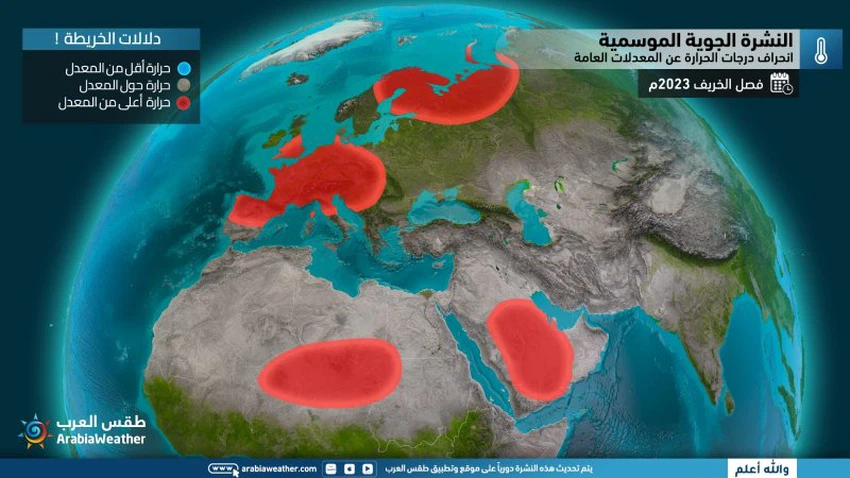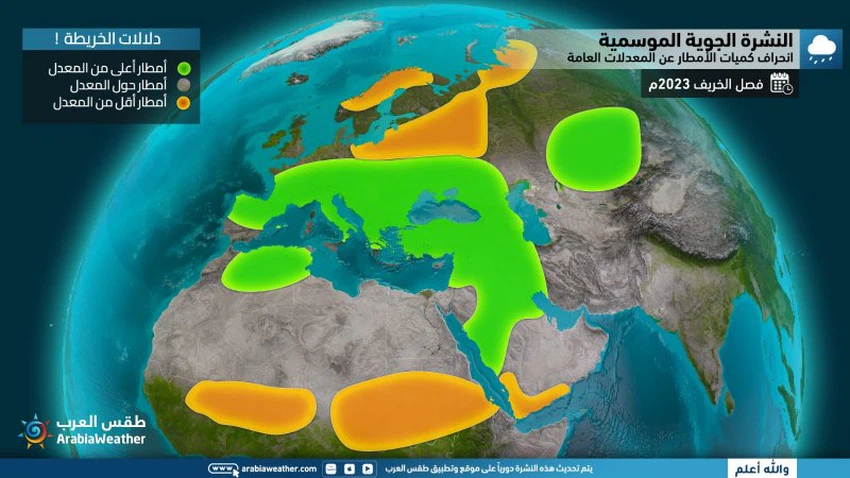Saudi Arabia | Quarterly bulletin for the fall of 1445 AH, corresponding to 2023 AD: A gradual decline in the severity of the heat as the coming months pass and an expected early start to the season.
Saudi Arabia | Quarterly bulletin for the fall of the year 1445 AH corresponding to 2023 AD: A gradual decline in the severity of the heat as the coming months pass and an expected early start of the season.
The most prominent weather phenomena expected:

General situation:
- The severity of the heat will gradually decrease in all regions with the passage of the coming months, and the weather will tend to be moderate at night. Despite this, temperatures are expected to be higher than their usual levels, with values ranging between (1-3) degrees Celsius in many regions.
- The so-called Red Sea Depression is gradually active over periods of October and November, which in turn brings unstable weather conditions and the many accompanying weather phenomena such as rain and dust.
- High chances of rain on the Red Sea coast, including Jeddah, during the month of November.
- Winds stirring dust and dust are active in several regions of the Kingdom as we gradually enter the fall season. This is due to the advance of less hot air masses from the eastern Mediterranean and the northern Arabian Peninsula, and the occurrence of thermal differences with the hot masses that already dominate the Arabian Peninsula, and this naturally leads to activity in surface winds.
- During some periods, surface humidity levels rise in areas overlooking the Arabian Gulf, with the possibility of fog and dense fog forming.
- Tropical activity is expected in the Arabian Sea during the second period of the tropical season, which precedes the onset of the monsoon winds.
Temperature deviations from general averages:

Rainfall deviation from general averages:

Weather condition for each month:
First month (September) 2023:
- Rain
- Below average in the southwest of the Kingdom (scattered cumulonimbus clouds at periods of the month accompanied by rain of varying intensity).
- Temperatures
- Higher than their rates in most of the northern and northwestern regions, in addition to the eastern region.
- About the usual rates in other regions
- Description of weather systems
- Normal atmospheric pressure values prevail over the atmosphere of the Arabian Peninsula, so that the subtropical high pressure continues to dominate the high layers of the atmosphere.
- As a result, temperatures are slightly higher than normal in several regions of the north and east of the Kingdom, while they are around their average in the central and southern regions, with hot weather in general. The weather also tends to be moderate at night, especially in the second half. Of the month.
- At intervals, less hot air masses approach the eastern Mediterranean and the northern Arabian Peninsula, causing thermal differences with the hot masses that already dominate the Arabian Peninsula. This leads to activity in surface winds and the stirring of dust and dust.
- The rain area begins to shrink and its intensity weakens in the southwest of the Kingdom, and these rains occur at intervals and are less than their normal rates.
- Surface humidity rises in the eastern region on some days of the month, causing waves of fog and a decrease in horizontal visibility.
Second month (October) 2023:
- Rain
- About average in most areas (cumulus clouds at intervals accompanied by scattered rain).
- Higher than average in parts of the north and west of the Kingdom (scattered cumulonimbus clouds accompanied by rain of varying intensity, especially during the second half of the month).
- Temperatures
- Higher than average in large areas of the Kingdom
- Description of weather systems
- The seasonal upper air high over the Arabian Peninsula gradually weakens, coinciding with the chances of cold upper basins arriving in the north of the Arabian Peninsula and Egypt, resulting in:
- A decrease in temperatures in most regions of the Kingdom compared to what was the case in previous months, and this decrease is more noticeable at night.
- A surface response to the Red Sea depression, which leads to the proliferation of cumulus clouds in some periods, especially the second half of the month, and is accompanied by many weather phenomena, including rain and activity in the descending winds that cause local sand storms.
- Surface humidity continues to rise in the eastern region and waves of dense fog form on some days of the month.
Third month (November) 2023:
- Rain
- About the average in most regions, while its rates exceed in separate parts of the north, east, center and west of the Kingdom.
- Temperatures
- Converted to higher rates in various regions of the Kingdom
- Description of weather systems
- It is expected that the tropical high will gradually shift to the southeast of the Arabian Peninsula. As a result, it is expected that the chances of heat waves occurring will decrease and temperatures will drop significantly, especially at night and morning.
- The flow of moisture-laden eastern winds increases at times towards the Arabian Peninsula, where various regions of the Kingdom are expected to be affected by cases of air instability at several periods of the month.
- The chances of thunderstorms are also gradually improving in the west of the Kingdom, including Jeddah. Surface winds are also expected to be active in several regions as moderate air masses approach the eastern basin of the Mediterranean Sea.
God knows best and highest.
How is the seasonal weather forecast issued?
Issuing these forecasts depends on studying the behavior of temperature and atmospheric pressure in the northern hemisphere, including the atmosphere and major bodies of water, and integrating those forecasts with global monitoring centers to produce the highest possible forecast accuracy.
Arab weather experts in the Scientific Research and Development Department have developed scientific methods that are considered the first of their kind in the Arab world and the world, as they rely on artificial intelligence in forecasting the coming months, by developing complex mathematical algorithms and equations to reveal the behavior of the atmosphere and correct long-range weather forecasts.
In contrast to the daily weather bulletin, these bulletins focus on listing the general weather condition during a month, where their goal is to know the deviation of rainfall amounts and temperatures from their general averages. Many meteorologists in the world are busy trying to solve the mystery of achieving accurate seasonal forecasts by conducting a lot of research in this regard, part of which the Arabia Weather team participates in.
The desired benefit of the quarterly bulletins lies in helping various sectors in early planning for both the fall and winter seasons, especially the agricultural sector, which builds its agricultural plans on these indicators, which sometimes help in reaping and making profits by exploiting this information, in addition to many other sectors that Benefiting from these forecasts, such as the commercial sectors, the apparel sector, the energy sector, and others.
Arabia Weather App
Download the app to receive weather notifications and more..



